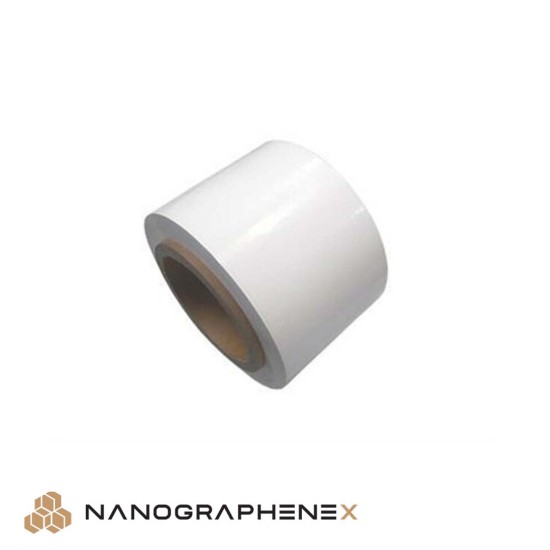One of the most critically important cell components to guarantee cell safety is li-ion battery
separator, a kind of microporous membrane that physically separates the anode and cathode
to prevent internal short circuit. Li-ion battery separator has good mechanical property and
chemical stability. For applications requiring the highest uniformity, we offer li-ion battery
separator with lowest price.

- Stock: In Stock
- Brand: Nanographenex
- SKU: GX03BE0105
Available Options
Li-Ion Battery Separator Film
Length: 800 m, Width: 85 mm, Thickness: 25 μm
Technical Properties:
Thickness
25 μm
Width
85 mm
Length
800 m
Gurley JIS
620 seconds
TD Shrinkage @ 90°C / 1 hour
0%
MD Shrinkage @ 90°C / 1 hour
5%
Porosity
39%
Pore Size
0.21 x 0.05 μm
Puncture Strength
380 grams
Tensile Strength, MD
1700 Kg/cm^2
Tensile Strength, TD
150 Kg/cm^2
Thickness | 25 μm |
Width | 85 mm |
Length | 800 m |
Gurley JIS | 620 seconds |
TD Shrinkage @ 90°C / 1 hour | 0% |
MD Shrinkage @ 90°C / 1 hour | 5% |
Porosity | 39% |
Pore Size | 0.21 x 0.05 μm |
Puncture Strength | 380 grams |
Tensile Strength, MD | 1700 Kg/cm^2 |
Tensile Strength, TD | 150 Kg/cm^2 |
Applications:
It can be used as li-ion battery separator in battery R&D.
The need for electric energy storage systems are in increasing demand. Lithium-ion batteries represent the best option for many applications such as hybrid and electric vehicles
which require high energy density, cycle durability and charge/discharge efficiency. Li-ion batteries have been used in many electronic devices since their production in 1990.
The components of the cell are primarily the positive and negative electrodes and the electrolyte. The positive electrode is a metal oxide, negative electrode is made of carbon and the
electrolyte is a lithium salt in organic solvent. The improvement in the performance of the battery can be done by the introduction of new materials with superb properties. Graphene
which is one of the best materials discovered by humans has opened new possibilities in the field of lithium ion battery materials due to its light weight, high electrical conductivity, superior
mechanical flexibility, and chemical stability.
Graphene can be used in both positive and negative electrodes of the battery. In the positive electrode, the cathode, it is used as a lithium metal oxide-graphene composites which
enhance the electrochemical properties of the battery by increasing the diffusion kinetics of the lithium ion and improve the stability across a wide voltage range in crystalline oxide-graphene
composites. In the negative electrode, the anode, the addition of graphene to anode materials has led to superior electrical conductivity, high surface area (2620 m2/g), high surface-to-volume ratio,
and ultra-thin thickness. These excellent properties can shorten the diffusion distance of ions, structural flexibility, thermal and chemical stability which guarantee its durability in harsh environments1.
It can be used as li-ion battery separator in battery R&D.
The need for electric energy storage systems are in increasing demand. Lithium-ion batteries represent the best option for many applications such as hybrid and electric vehicles
which require high energy density, cycle durability and charge/discharge efficiency. Li-ion batteries have been used in many electronic devices since their production in 1990.
The components of the cell are primarily the positive and negative electrodes and the electrolyte. The positive electrode is a metal oxide, negative electrode is made of carbon and the
electrolyte is a lithium salt in organic solvent. The improvement in the performance of the battery can be done by the introduction of new materials with superb properties. Graphene
which is one of the best materials discovered by humans has opened new possibilities in the field of lithium ion battery materials due to its light weight, high electrical conductivity, superior
mechanical flexibility, and chemical stability.
Graphene can be used in both positive and negative electrodes of the battery. In the positive electrode, the cathode, it is used as a lithium metal oxide-graphene composites which
enhance the electrochemical properties of the battery by increasing the diffusion kinetics of the lithium ion and improve the stability across a wide voltage range in crystalline oxide-graphene
composites. In the negative electrode, the anode, the addition of graphene to anode materials has led to superior electrical conductivity, high surface area (2620 m2/g), high surface-to-volume ratio,
and ultra-thin thickness. These excellent properties can shorten the diffusion distance of ions, structural flexibility, thermal and chemical stability which guarantee its durability in harsh environments1.






